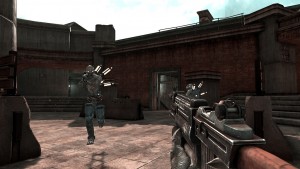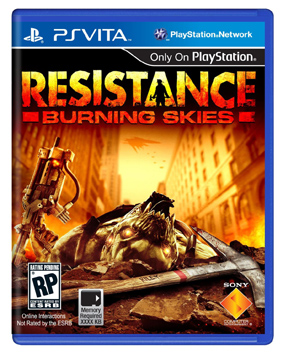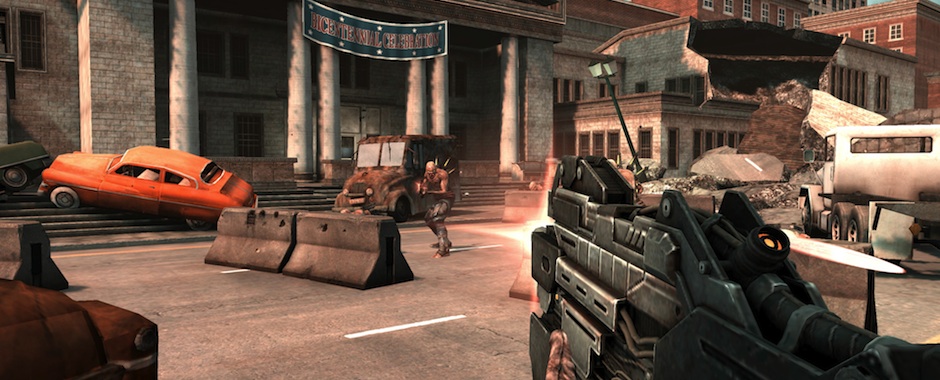This game has managed to pop into our radar more than a few times. We first saw it at Sony’s PlayStation Vita Preview Event in Toronto. Then, it creeped up on us at the Sony Spring Showcase last month. Finally, it made its way into our hands, and the Resistance: Burning Skies, for the most part, didn’t disappoint.
The game starts off with some cutscenes done up in a sort of comic-book style without a lot of finesse. The framerate doesn’t lag or anything, but the frames aren’t as polished as they could’ve been. With that said, they’re rather basic and they don’t do anything incredible design-wise given the fact that they’re pretty boring cutscenes at that.
 Then the game starts. You’re thrust into a world that we haven’t seen on a handheld platform before. It’s not as beautiful as Wipeout 2048 and it certainly doesn’t hold a candle to anything we’ve seen from recent console shooters like Ghost Recon Future Soldier, but the game still looks stunning for what it is supposed to be. You’re playing a shooter here, and while the graphics aren’t everything, the developers certainly haven’t forgotten about them.
Then the game starts. You’re thrust into a world that we haven’t seen on a handheld platform before. It’s not as beautiful as Wipeout 2048 and it certainly doesn’t hold a candle to anything we’ve seen from recent console shooters like Ghost Recon Future Soldier, but the game still looks stunning for what it is supposed to be. You’re playing a shooter here, and while the graphics aren’t everything, the developers certainly haven’t forgotten about them.
Controls are as you might expect: shoulder buttons aim and shoot, face buttons control weapon swaps and jumping, and the analog sticks are for movement and aiming. Of course, there is a massive touchscreen on the Vita, and developer Nihilistic certainly didn’t forget about it. Your axe and grenades are deployed by tapping their respective icons on the touch screen, and doors have contextual controls pop-up when they can be opened. There were a few cases where our finger would slip off the square button and tap the screen, wasting a grenade, but that happened maybe three or four times throughout the six hour campaign.
Enemies are quite a breeze, and while you’ll die a few times in the campaign, it probably will be more a result of carelessness than it will be of a lack of skill. In fact, the bosses in the game are sometimes easier than the enemy populace and it becomes annoying at time that they almost wait for you to shoot at them. Your Bullseye, a gun with bullets that redirect towards enemies, certainly doesn’t make the game any harder.
 Audio in Burning Skies is unfortunately not as cheery a story as the gameplay and graphics. On the one hand, the audio is fitting for the time, but we’re not entirely sure that the developers were going for distorted audio just because the game is set in the ’50s. Simply put, the music doesn’t really fit the game, bullets and other gunfire doesn’t have any directional sound to it, and the game is just a total blasphemy in the audio department.
Audio in Burning Skies is unfortunately not as cheery a story as the gameplay and graphics. On the one hand, the audio is fitting for the time, but we’re not entirely sure that the developers were going for distorted audio just because the game is set in the ’50s. Simply put, the music doesn’t really fit the game, bullets and other gunfire doesn’t have any directional sound to it, and the game is just a total blasphemy in the audio department.
The storyline is kind of a bore here, too. You never quite feel like you know the character you’re playing, and while it seems easy enough to navigate through, that’s because it is. This is a super linear game that directs you to exactly where you want to go. And the storyline has so few twists in it (i.e. none) that you know the ending of it when you first fire up the game.
Think of Burning Skies as a kind of guinea pig. The game does exactly what it needs to do: be a statement and show the world that handheld shooters work. Because the gameplay in Burning Skies is exactly what we came into the game for. While there may be some design decisions that don’t make a ton of sense, the game is fun. And that’s all we really expect from these things.

